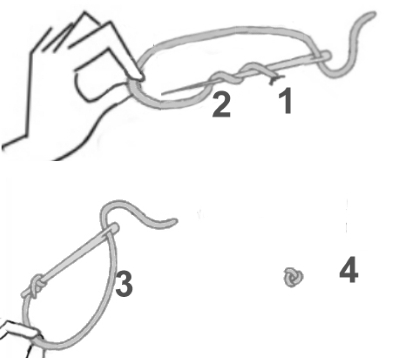Tips Blog
09/2019 - TIP - FRENCH KNOT
This month's tip is short and sweet - and I may have mentioned at least part of this tip before... but one of the things I hear most often from stitchers, is that they hate doing French knots - they come out misshapen, with loops of thread sticking up, or any number of other imperfections.
But actually, French knots aren't difficult at all - the trick is in the TENSION. When you come up from the back of the fabric, pull the floss gently but firmly away from the base of the stitch, and KEEP TENSION on the strand during the rest of the steps.
Now, I'm right handed, so I'm going to tell you how I work a French Knot right-handed. If you are left-handed, simply reverse these instructions.
Holding the floss several inches from the base with your left hand, and pointing the needle in the same direction, wrap the floss 2-3 times around the needle (away from the base of the strand, along the length of the floss (1-2 on the top diagram, below). Most instructions call for a double wrap, but if you want a larger / thicker knot, or are using a very fine thread, then wrap 3 times.
Keep holding the floss strand firmly taut, while you push the needle back down through the fabric (3 on the bottom diagram). If the floss is fairly thick, you may go back down in the same hole you came up in, and the thick knot will sit on top of the fabric. If the floss is thinner, or the fabric is loosely woven enough that the knot may easily pull through the fabric, then go down one fabric strand over from your starting position (this strand will catch the knot, and prevent it pulling through to the back of the fabric).
Gently draw the floss strand tight, forming the knot, allowing the floss strand you're holding to feed down through the opening, until a small tight knot is formed. Your knot should look like diagram 4, below.

Now, here's a tip you may like even better <wink>. If you still really, really, really, hate French Knots, you can replace them with seed beads of the same size and color! This simple trick keeps a uniform size and shape to all 'knots', while giving a very similar look to the French Knots. That's it for this month... talk to you later...